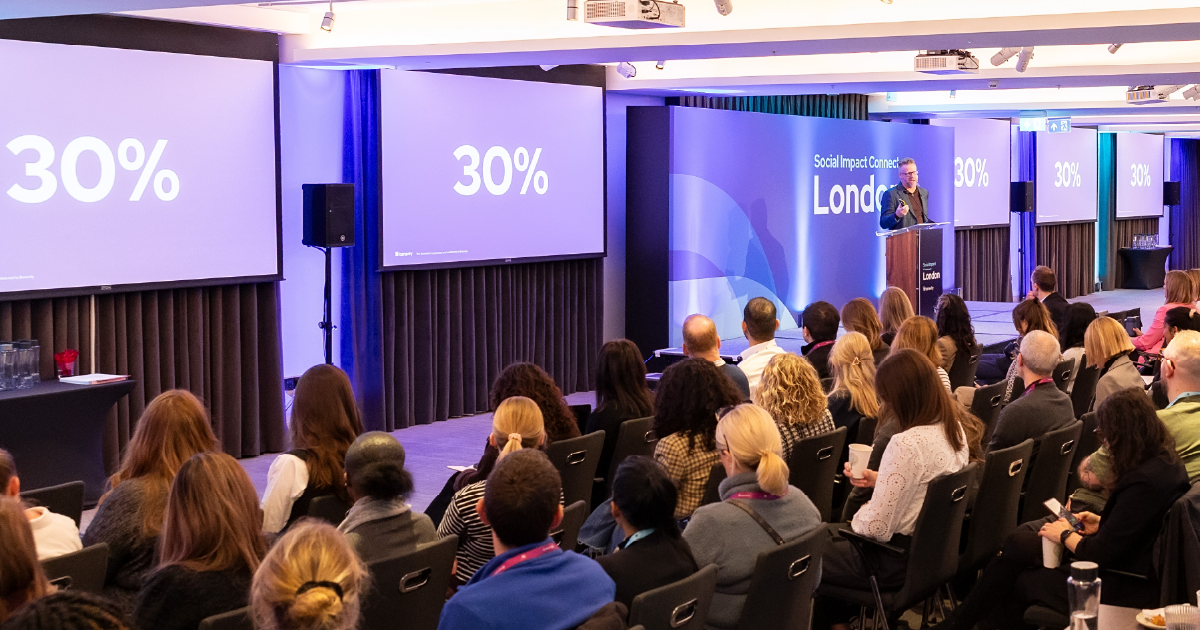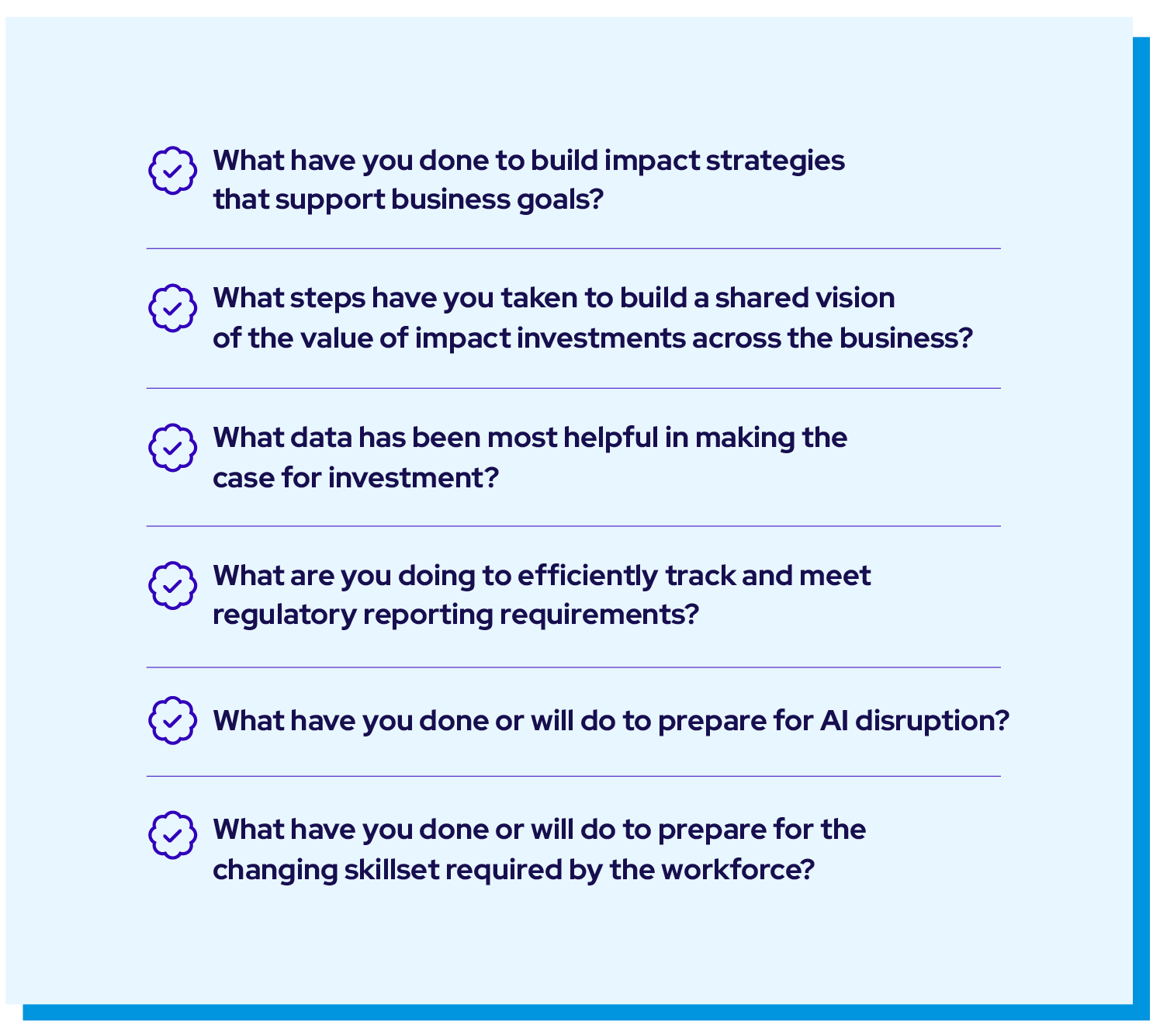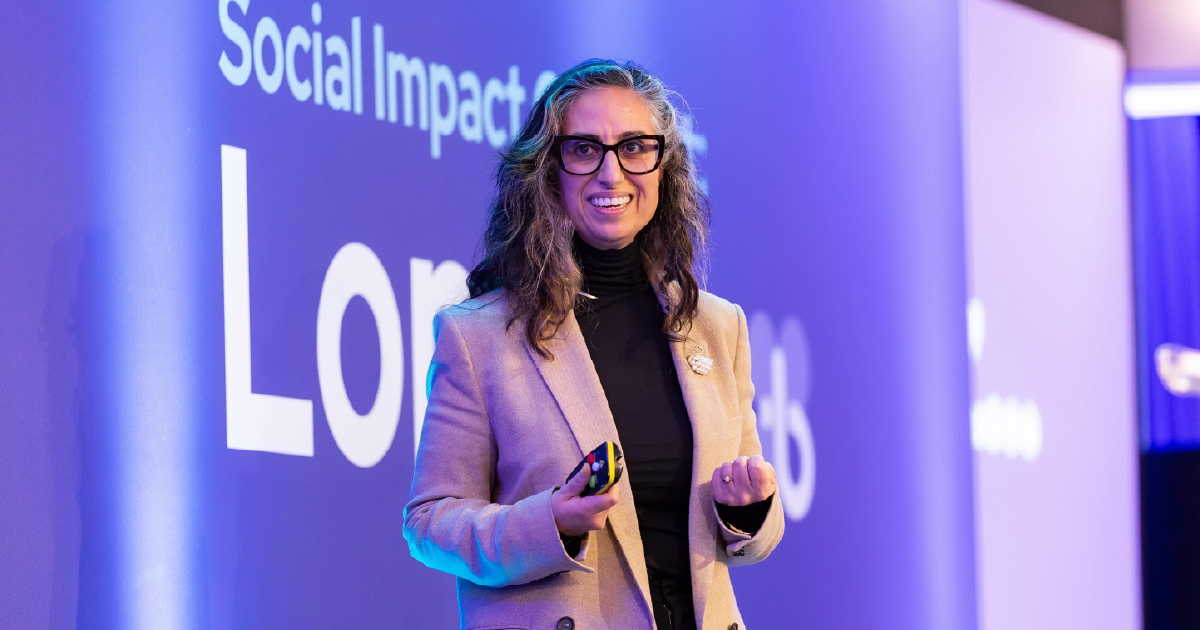This year's Benevity Social Impact Connect: London brought together more than 150 purpose-driven leaders from across the UK and beyond. Their shared mission: to build upon the power of community — exploring how AI, data and human generosity — are intersecting to transform workforce social impact from a CSR activity into a strategic business advantage.
“Being at Social Impact Connect: London makes me feel inspired and even more energized to work with Benevity on our strategy.” – Benevity London Impact Connect attendee
Across sessions, panels and workshops, one message rang clear — purpose at work is now a business imperative. The enterprises leading the way are embedding impact into strategy, measuring outcomes with rigor and using technology to make doing good go further.
AI can accelerate social impact powered by human generosity
In a keynote conversation, Ian Goldsmith, Chief AI Officer at Benevity, emphasized that AI is not a luxury add-on — it is central to scaling social impact and linking business goals to purpose outcomes. From summarizing grants to identifying employee engagement trends, AI is reducing administrative burdens and freeing leaders to focus on strategic impact. As Goldsmith noted, AI is the enabler that moves purpose-driven organizations from “doing good” to doing good at scale—aligned with measurable business outcomes.
Key findings from the 2025 Benevity Impact Labs State of Corporate Purpose report reflect a growing interest and acknowledgement of the potential value of AI in CSR.
- 92% of CSR leaders say they invest in social impact because it’s good for business.
- 64% of companies use AI for grant-application summaries and 62% for reviews.
- 82% say nonprofits need corporate support to bridge the AI gap.
From Goldsmith’s perspective, AI enables enterprises to build employee personas, tailor internal training and engagement offerings, and align social-impact programs to employee motivations — as well as drive analytics and insights into participation trends and link to business KPIs. In addition, AI reduces administrative burdens so more time is spent on strategic impact.
Benevity AI will focus on transforming the employee experience and streamlining grantmaking processes — saving teams up to 20% of their time. These efficiencies will empower programs, teams and employees to focus on strategic initiatives and create even greater impact each week. The results? Faster funding for organizations doing critical work — and a win for every stakeholder in the impact ecosystem.
The AI session wrapped up with a fireside chat with Laura Turkington, Corporate Responsibility, Commercial & Innovation Leader at Ernst & Young. Goldsmith and Turkington focused on the potential of AI across the impact sector — from nonprofits to CSR teams — to save time and drive efficiencies. They also discussed how AI can responsibly accelerate innovation, tackling some of the world’s biggest challenges, from climate change to affordable, quality education.
Both Goldsmith and Turkington emphasized the same point: AI is the enabler that will allow us to do good at scale, aligned to measurable business outcomes.

Purpose works best when it’s co-created across business units, employees and partners
Leaders from Boehringer Ingelheim, Collinson Group, and The Felix Project demonstrated what happens when business, employees and communities collaborate for shared value.
Edison Núñez, Social Sustainability Leader at Boehringer Ingelheim, opened with a profound question: "What if every act of volunteering could directly amplify business impact?"
“What if every act of volunteering could directly amplify our business impact?” – Edison Núñez, Social Sustainability Leader at Boehringer Ingelheim
Boehringer Ingelheim is a healthcare company with an impact program that aims to save the lives of stroke victims. With a collaboration model that includes connecting schools, families and medical systems, and strategic volunteer opportunities that align with business priorities, the company is able to align multiple stakeholders to achieve their goals. From a metrics viewpoint, the organization measures how many children are reached, how many schools are engaged, and how many “stroke-ready” hospitals are available.
This is a vivid case of embedding social purpose into a healthcare business model, with collaboration across systems and scalable reach. Núñez concluded with incisive advice: “Talk to business areas, understand their challenges and co-create solutions for shared value.”
Benevity clients Sarah Thake, Head of Community Impact and Flora Hewitt-Brake, Social Impact Lead at Collinson Group shared a pragmatic framework for CSR program growth. They lead the Collinson Community initiative and shared three critical levers for success: remove barriers to participation, provide a platform for engagement and participation, and have a specific budget for growth and improvement.

Thake and Hewitt-Brake led the Collinson Community initiative from 0.2% profit invested and 2% colleagues engaged to 3.5% profit invested and 57% colleagues engaged and concluded their story stating: “This is just the beginning.”
Will Savage, Head of Corporate Partnerships at The Felix Project offered a nonprofit lens. As a London-based charity rescuing surplus food and redistributing it to charities, schools and holiday programs, this initiative has moved beyond their mission of giving food to become London’s largest food redistribution charity.
The example shared by Savage touches on all the leadership-track pillars: objective clarity, stakeholder engagement, collaboration (food suppliers + charities + volunteers), measurement (tonnes of food, meals served, suppliers engaged), and scale.
Each of these changemakers at Social Impact Connect: London offered valuable insights into the power of aligning social impact initiatives with business value. They also offered a disciplined look at program best practices and measurement. These common themes facilitate CSR program growth driven by measurable, impactful results for businesses, employees and communities.
Future-proof programs with a focus on measurement and radical collaboration
As part of a leadership track, Sona Khosla, Chief Impact Officer at Benevity and Edmond Palao, Director of Client Success at Benevity hosted a collaborative workshop with more than 30 CSR and social impact leaders and explored lessons learned and themes for the months ahead.
The workshop began with some data-driven reminders: Benevity U.S. and U.K.-based research across 500 organizations suggests that CSR budgets are rising (76% of CSR leaders anticipate an increase), and executives see CSR as a way to achieve business goals based on ROI (50% in the U.K., 43% in the U.S.). However, enhanced scrutiny and improved measurement remain critical (45% agree on the lack of KPIs to measure success). The leaders in attendance across a variety of organizations then grouped up to respond to one of six key questions as they look ahead to 2026 and beyond:

There were many lively discussions as the groups worked through the questions, but five key themes emerged from the workshop:
1. Shift from siloed CSR to an impact-first mindset organization-wide
Engagement grows when purpose is embedded across business processes. Organizations must evolve their mindset and train all employees to see CSR impact as a core driver of organizational value.
2. Align impact programs with business goals and financial clarity
Effective leadership defines measurable impact programs tied to business objectives and shareholder value. Ground initiatives in company goals and values (e.g., the previous Boehringer Ingelheim case study), and anchor plans with ROI, budgets and OKRs. Create clear business-unit pitches that define outcomes, showcase impact and use competitive benchmarks to demonstrate business value.
3. Engage stakeholders at every level
Alignment requires both top-down and grassroots collaboration — listening internally, partnering externally and empowering “intrapreneurs” to champion impact within their teams.
4. Collaborate radically for measurable impact
Radical collaboration builds a unified voice of purpose, connecting societal, business and community goals. Success is measured not just by participation but by tangible outcomes, shared stories and benchmarking.
5. Future-proof impact with AI and regulatory readiness
Impact leaders recognize AI integration is inevitable, yet preparedness remains uneven. Emerging approaches include using AI to build internal employee personas that inform strategy and tailor outcomes. While regulatory guidance is limited, forward-thinking leaders are using regional standards to future-proof global programs.

Impact and inclusion accelerates through innovation, data and community
In addition to her role as Chief Impact Officer, Sona Khosla also heads up the Benevity Impact Labs and led a main-stage session on The State of Corporate Purpose. While there are regional variances for CSR practitioners all over the world, she shared some common themes from the Benevity 2025 State of Corporate Purpose report:
"One of the key moments from the event was when Sona Khosla shared the quote, “Pressure is a privilege.” It really resonated with me. Overall, the shared vision and the connections I made that day with fellow changemakers were inspiring." – London Impact Connect attendee
- Enterprise impact is here. It's no longer siloed, as evidenced by evolving strategies, changing leadership, and increasing engagement with teams within an enterprise. Investment in social impact is also not slowing down, just changing shape.
- 56% of enterprises are planning to increase their social impact statements and commitments this year; three-fourths of nonprofits want companies to be courageous in telling community stories; and 80% of companies want to support nonprofits in measuring impact so they can focus on fundraising.
- Purpose is a driver for business performance. 88% of leaders say their impact strategies are future-proofing their business across talent attraction and retention, customers and regulatory readiness. Additional research by Chief Executives for Corporate Purpose finds that companies with a corporate purpose statement had 58% more revenue growth.
- ERGs continue to be critical. 91% of impact leaders see ERGs as an important part of their value proposition and 92% of corporate leaders consider ERGs to be important, according to Benevity research.
Purpose leaders are clearly in a moment of transition, and as Khosla stated “Whatever is strategic gets scrutinized — and purpose is now strategic.”
From CSR to core strategy
Social Impact Connect: London underscored that social impact is no longer optional or peripheral as a CSR activity — it is core to strategy, stakeholder trust, employee engagement and business resilience. With the integration of AI, stakeholder alignment, collaboration across business and community, and robust metrics, enterprises can turn purpose into performance by:
- Defining clear, measurable objectives: Don’t start with volunteering or giving. Start with the business objective. Define what the company wants to achieve and then design your CSR program to support it, including metrics like budget and ROI.
- Engaging stakeholders to champion purpose at work: Listen to what is being talked about across teams — what are employees asking? what are your learning and development needs? what is the appetite for volunteer opportunities? — and connect it to top-down business goals. Invite intrapreneurs to advocate internally.
- Embedding collaboration and partner networks: Mobilize cross-functional teams: HR, CSR/impact, communications, operations, supply chain, customer-facing teams and more. Incorporate your supply-chain and customer voices. And link volunteering or social programs directly to business unit goals.
- Using AI to scale social impact and empower nonprofits: Apply AI to build employee personas (who volunteering motivates, who does giving appeal to), tailor programs and communication. Use AI/analytics to optimize engagement, route volunteers, segment impact, measure outcomes.
- Measuring with rigor: Track your outcomes, develop success stories and revisit your original planning. Determine if you are meeting your original goals, and continue to refine your program as needed.
As the conversations at Social Impact Connect: London made clear, the future of CSR and grantmaking in the U.K., and globally, is being reshaped by AI innovation, data-driven decision-making and authentic community collaboration. Put simply, purpose scales when it’s strategic. London’s social impact leaders are proving that when purpose and performance align, the result is more than good business — it’s transformative change. By embedding impact strategy into core operations, leveraging AI to scale social good and fostering radical collaboration across industries, U.K. enterprises are setting a global benchmark for what modern CSR can achieve. The message from London is clear: the next era of corporate responsibility is not just about doing good — it’s about doing good at scale, with measurable impact and sustainable business growth.









